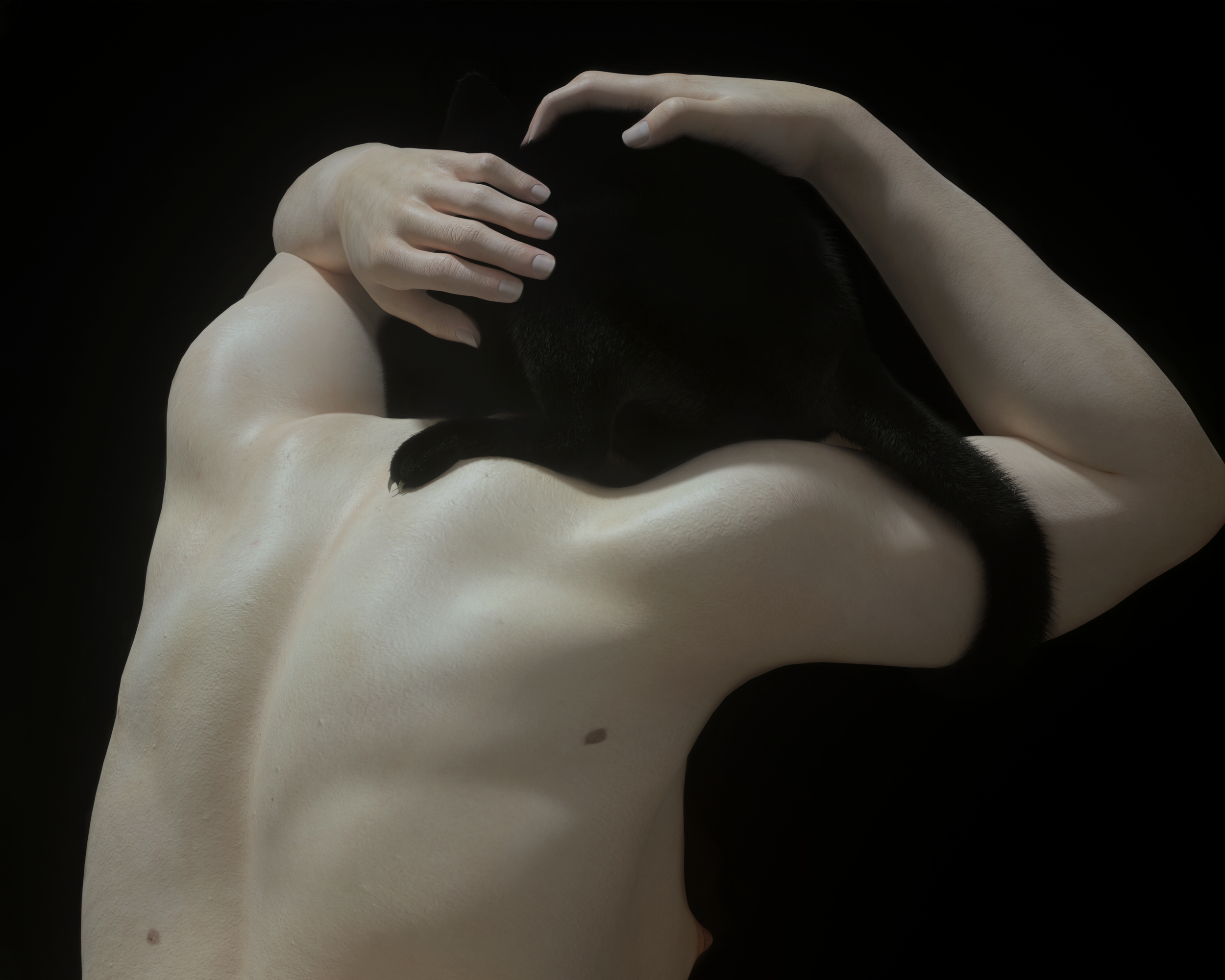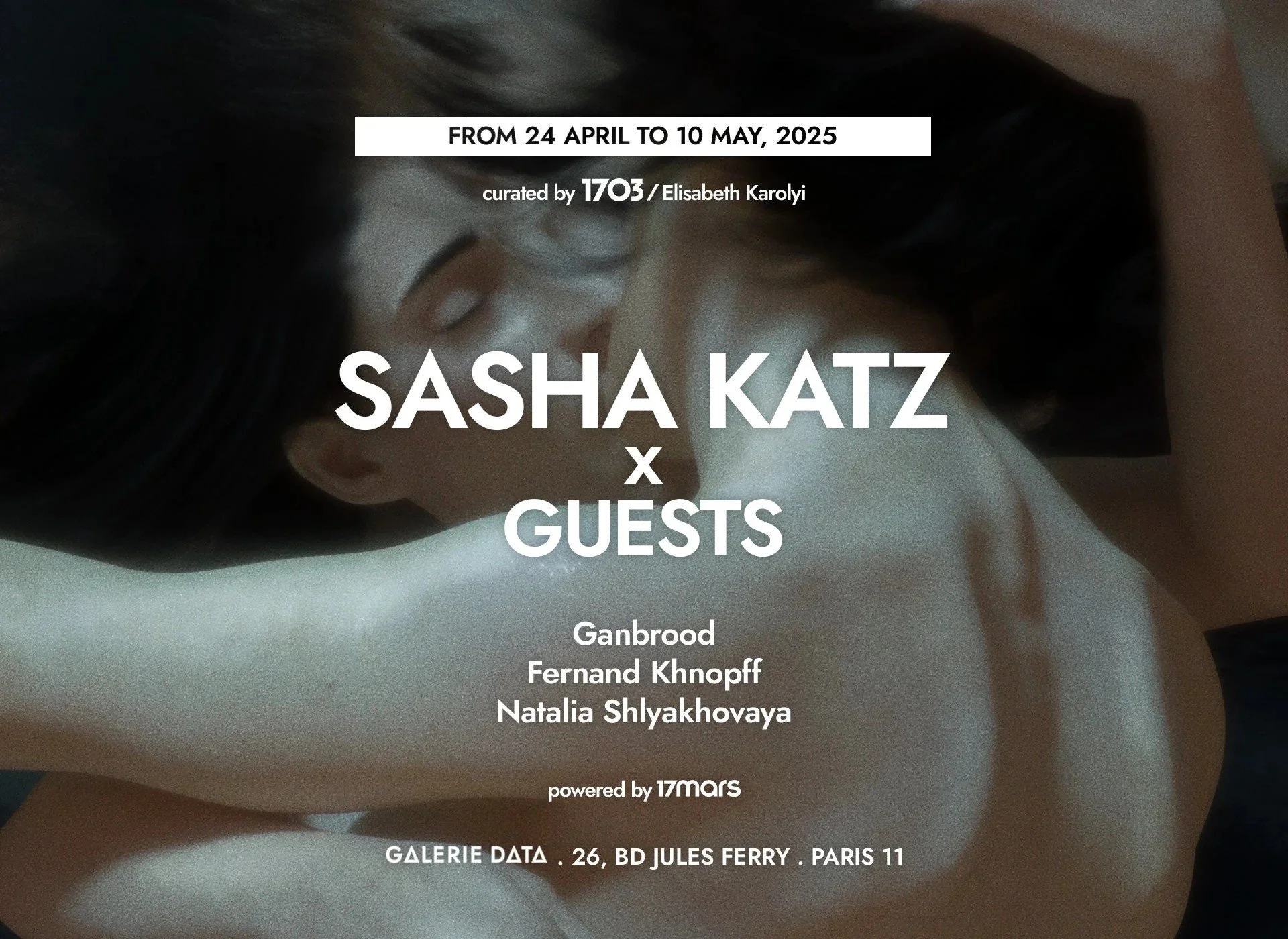On Sasha Katz’s liminal theatre of identity
Let your mind step into Sasha Katz’s upcoming solo exhibition at Galerie Data, where you will be drawn into a world where female subjects appear to hover between the tangible and the illusory. Modeled in 3D yet printed and framed, the figures possess a mesmerizing theatricality. This calculated ambiguity, teetering somewhere between photorealism and waxlike artifice, evokes a long lineage of artistic practices that challenge what we conventionally accept as ‘real’.
Seeds of inspiration: Vrubel and the Russian imagination
Raised amid the layered cultural fabric of Moscow, Sasha Katz (1984) absorbed fairy tales and the folkloric tradition of Slavic mythology - mermaids, forest spirits, shape-shifters, combined with reading science books and influential visits to art exhibitions with her grandmother. During one of those visits, a retrospective of Mikhail Vrubel left her in awe.
One of Russia’s seminal painters, Vrubel (1856–1910) is considered a visionary who both encapsulated the mystique of Russian folklore and myth and redefined the very language of modern art at the same time. He was a leading figure of the Symbolist movement, whose paintings explored themes of transcendence, inner torment, and ‘the sublime’. His dramatic interpretations set him apart from his contemporaries, ranging widely from haunting figures to richly textured religious subjects. Vrubel’s art is also characterized by a very potent interplay of light and shadow, almost a vigorous treatment of color [especially back then], and a willingness (or deep urge) to probe into the depths of human emotion and myth. His work subtly yet powerfully deconstructed traditional motifs, offering instead an introspective, almost prophetic vision of existence.
Karabasan, 2023
Little Sasha saw how the painter had depicted mystical themes in large scales. She was captivated by his demons and this encounter of myth and matter on canvas became an obsession she would soon make her own. To this day, Vrubel remains a guiding constellation in Katz’s practice. His depiction of unearthly figures, frequently suspended between the sacred and the infernal, taught Katz that art could be at once graceful and disturbing, that it might both enthrall and provoke.
In Katz’s series such as Karabasan, which draws inspiration from Henry Fuseli’s iconic painting The Nightmare, Katz lifts mythic terror into a contemporary idiom and here you can see how the fascination for Vrubel’s work stayed with her. The languid female subjects, half-awake in a glow that merges dreams with nightmares, echo Vrubel’s search for the intangible—those flickers of the mind too elusive to show plainly. Where Vrubel once used large-scale canvases to heighten the drama, Katz employs digital technology and photographic framing. In the resulting images, white bodies contort beneath intangible pressures, black cats slink through the frame, and everything feels both intimate and unsettling at the same time.
Non-standard beauty, or radical femininity
In current times, Katz’s reflections on bodily representation - especially of the feminine form - draw from another lineage of artists: those who question conventional beauty. Rather than rendering a neat, standardized perfection, Katz casts real bodies in moody tones – an approach reminiscent of the unidealized figures one might find in the early modern period, or in late nineteenth-century artists unafraid to flirt with what society deems unsightly. The result is a frank embrace of imperfections that, paradoxically, seem to actually elevate her subjects into something deeply human, with a timeless quality and a compassionate feel.
In the Radio Silence series, solitary figures exhale cigarette smoke, their thoughts seemingly adrift in the static hush of an unresponsive radio. Katz describes this limbo as “a bridging mechanism – a white noise that connects isolated souls through a common void.” In centuries past, Symbolists insisted that the invisible and the interior could be brought to the surface through visual signifiers: a certain tilt of the head, a soft blur at the edges or a hush of muted color, for example. Katz updates that ethos, foregrounding the vulnerability and resilience of each subject. The hush in her work is not just a formal effect, but a state of mind.
Whispers #3, 2023
Ancient dragons and hidden whispers
Another apparent example of Katz’s synthesis of myth and modernity lies in the works of Whispers, where the presence of Japanese dragons, inspired by late Edo-period illustrations, runs across women’s skin like living tattoos. In Japanese art, dragons often symbolize transformative power and protective forces; historically, they presided over storms, guarded treasures, and manifested the link between the sacred and the earthly. By appropriating these swirling, serpentine forms, Katz wants to underscores a two-way conversation: these elaborate tattoos whisper back to the person wearing them, inciting us to wonder: can we, too, carry mythic narratives beneath our surfaces?
Edo Japan refers to the period between 1603 and 1868. During these more than two centuries, Edo (modern-day Tokyo) flourished as the political and cultural epicenter, cultivating distinctive art forms, literature, and traditions that continue to influence (Japanese) aesthetics today. In Edo Japan, dragons held an especially potent status, navigating the thresholds between spiritual and terrestrial realms. These serpentine entities - depicted with sinuous curves and dynamic, clawed limbs - symbolized wisdom, strength, and an auspicious promise of rain and prosperity.
By layering Dragon iconography onto her contemporary portraits, Katz forges a cross-temporal bond: the late Edo period’s fascination with ephemeral beings merges with her own commentary on selfhood and moral freedom. In her works, one can almost see the dragon tattoo coil to life, and there’s a feeling of both seduction and caution simultaneously. Who is in charge? The human body or the tattoo on it? Katz shows that the power of symbols such as dragons - and therefore her artworks as a whole – can both comfort and unsettle.
Mermaids and moonlit waters
Katz’s tendency to entangle mythic motifs with modern experiences emerges again in Yakamoz, titled after the Turkish term for the moonlight’s shimmer on water at night. Here, the shadowy underwater domain frames half-embrace figures who appear to hover in a quiet ecstasy, recalling mermaids from Slavic lore, or mavkas from Ukrainian legends (spirits of those who died unfulfilled, longing for mortal contact). The resulting compositions are tinged with both romance and sorrow, as if the intangible world beneath the sea offered a final resting place for lost desires.
Sasha Katz
The world of Sasha Katz
Amid the swirling discussions about AI-generated images, digital ownership, and the changing fabric of contemporary art, Katz’s creative output underscores the medium’s capacity for quiet introspection rather than mere technological spectacle. Though her technique is undeniably rooted in new technology, her end results feel timeless, guided by an emotional gravity that speaks to identity, sexuality, and power.
Where Vrubel and his Symbolist peers once turned to angels and demons to wrestle with intangible realities, Katz conjures catlike apparitions and watery illusions. Both worlds thrive on half-hidden truths, orchestrated in ways that provoke the viewer’s imagination. In a time when art often succumbs to superficial amusements or overtly didactic commentary, Katz chooses to inhabit the margins: her dreamy vistas emphasize that our most urgent truths sometimes live behind a curtain of mystery.
One might see her practice as a continuation of the abiding relevance of Symbolist gestures: forging images that refuse to pin down meaning, inviting viewers to confront the illusions and hopes that haunt everyday life. Katz does not present absolute statements about feminism, body politics, or cultural narratives; instead, she crafts the liminal scenes where every muscle flex and swirl of smoke suggests an unspoken possibility. Where will your thoughts take you? What are you thinking of? Who’s afraid of the darkness, or stepping into the marginal light?
Please note: more images will be posted in this article after the opening, Thursday April 24
Katz x Guests
From April 24 to May 10th 2025, seventeen artworks by Sasha Katz, from seven series created between 2022 and 2024, are displayed at the Galerie Data, Paris.
Besides that, there will also be three guest artworks on view: The Profile of Marguerite Khnopff by Fernand Khnopff, Doused in the Bright Light by Natalia Shlyakhovaya, and Heir Apparent by Ganbrood.
Presented by: 1703, a digital art hub created in 2022 by the brand design agency 17mars
Curator: Élisabeth Karolyi



